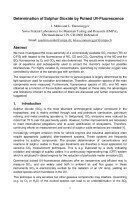Air monitoring
Determination of Sulphur Dioxide by Pulsed UV-Fluorescence
Oct 06 2014
Author: J. Mohn and L. Emmenegger on behalf of CEM
Abstract
We have investigated the cross-sensitivity of a commercially available SO2 monitor (TEI 43C-FG) with respect to the fluorescence of NO, CO and CO2. Quenching of the NO and the SO2 fluorescence by O2 and CO2 was also determined. The results were implemented in a set of equations and subsequently used to correct the monitor’s output for possible interferences. For highly variable O2 concentrations, quenching by molecular oxygen was
controlled by dilution of the sample gas with synthetic air.
The response of an UV-fluorescence monitor to various gases is largely determined by the light spectrum used for excitation and detection. Therefore, absorption spectra of the main components were measured. Furthermore, fluorescence spectra of SO2 and NO were obtained as a function of the excitation wavelength. Based on these data, the advantages and limitations inherent to the selection of filters are discussed and further improvements suggested.
1. Introduction
Sulphur dioxide (SO2) is the most abundant anthropogenic sulphur compound in the troposphere, and is mainly emitted through coal and petroleum combustion, petroleum refining, and metal smelting operations. In Switzerland, SO2 emissions were reduced by more than 75 % over the past twenty years. However, further improvements are necessary to meet international obligations and to avoid acidification of ecosystems. Therefore, continuing efforts on measurement and control of sulphur oxide emissions are needed [1].
Increasingly stringent emission limits for vehicle engines and industrial applications often require appropriate (catalytic) after-treatment systems. These systems are frequently sensitive to sulphur compounds. The precise determination of concentrations and reactions of sulphur oxides in (flue) gas treatments are therefore a novel application for sensitive SO2 measurement techniques. This is e.g. illustrated by a study indicating oxidation and storage of sulphur oxides in a continuously regenerating trap (CRT)-system which is employed in diesel engines for the reduction of particulate matter emissions [2].
Commercial pulsed UV-fluorescence detectors offer an inexpensive and efficient way to measure SO2, and are widely used both in ambient air and flue gases. In these instruments SO2 is electronically excited by the radiation of an UV lamp, yielding an excited species which fluoresces in the UV.
This technique is very sensitive but other gaseous components may interfere. Quenching (e.g. by O2 or H2O) of the excited species can lead to an underestimation of the SO2 concentration. Positive interference occurs by molecules which absorb radiation and fluoresce in the same region than SO2 (e.g. NO and HC) [3]. In exhaust gases, nitric oxide (NO) is usually the main positive interferences, while oxygen is the most important
quenching species if water vapour is removed by a Nafion dryer.
Digital Edition
AET 28.4 Oct/Nov 2024
November 2024
Gas Detection - Go from lagging to leading: why investment in gas detection makes sense Air Monitoring - Swirl and vortex meters will aid green hydrogen production - Beyond the Stack: Emi...
View all digital editions
Events
Jan 20 2025 San Diego, CA, USA
Carrefour des Gestions Locales de L'eau
Jan 22 2025 Rennes, France
Safety, Health & Wellbeing LIVE
Jan 22 2025 Manchester, UK
Jan 25 2025 San Diego, CA, USA
Jan 29 2025 Tokyo, Japan















